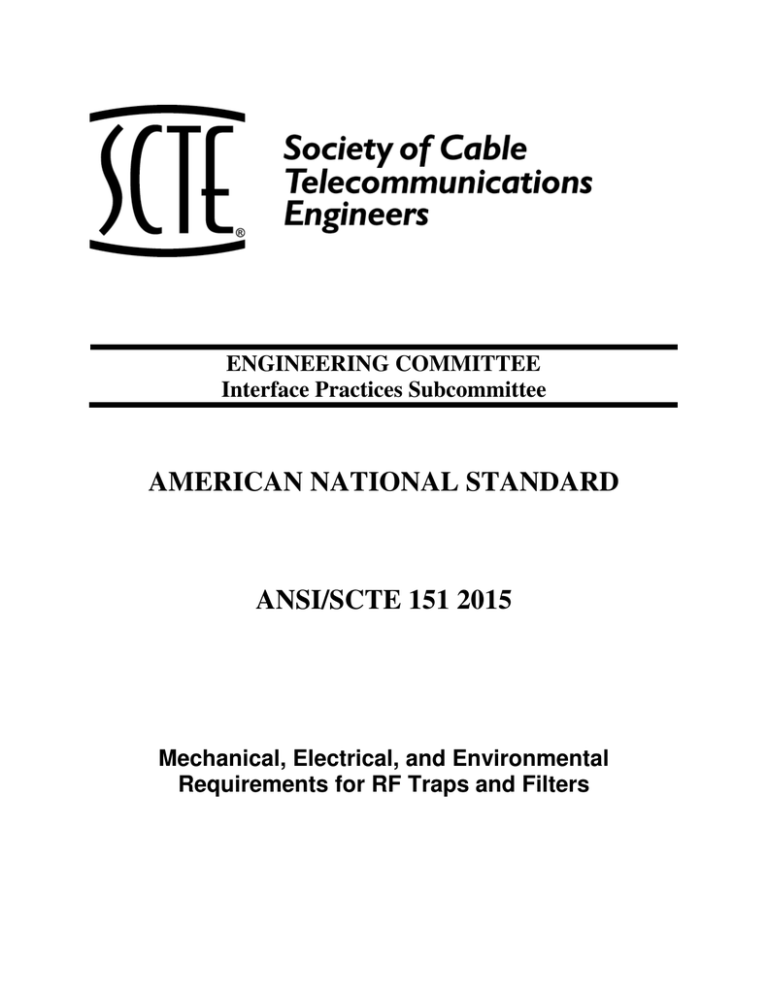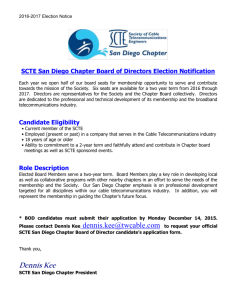AMERICAN NATIONAL STANDARD ANSI/SCTE 151 2015
advertisement

ENGINEERING COMMITTEE Interface Practices Subcommittee AMERICAN NATIONAL STANDARD ANSI/SCTE 151 2015 Mechanical, Electrical, and Environmental Requirements for RF Traps and Filters NOTICE The Society of Cable Telecommunications Engineers (SCTE) Standards and Recommended Practices (hereafter called documents) are intended to serve the public interest by providing specifications, test methods and procedures that promote uniformity of product, interchangeability, best practices and ultimately the long term reliability of broadband communications facilities. These documents shall not in any way preclude any member or nonmember of SCTE from manufacturing or selling products not conforming to such documents, nor shall the existence of such standards preclude their voluntary use by those other than SCTE members, whether used domestically or internationally. SCTE assumes no obligations or liability whatsoever to any party who may adopt the documents. Such adopting party assumes all risks associated with adoption of these documents, and accepts full responsibility for any damage and/or claims arising from the adoption of such Standards. Attention is called to the possibility that implementation of this document may require the use of subject matter covered by patent rights. By publication of this document, no position is taken with respect to the existence or validity of any patent rights in connection therewith. SCTE shall not be responsible for identifying patents for which a license may be required or for conducting inquiries into the legal validity or scope of those patents that are brought to its attention. Patent holders who believe that they hold patents which are essential to the implementation of this document have been requested to provide information about those patents and any related licensing terms and conditions. Any such declarations made before or after publication of this document are available on the SCTE web site at http://www.scte.org. All Rights Reserved © Society of Cable Telecommunications Engineers, Inc. 2015 140 Philips Road Exton, PA 19341 i TABLE OF CONTENTS 1.0 SCOPE .........................................................................................................1 2.0 NORMATIVE REFERENCES ...................................................................1 3.0 COMPLIANCE NOTATION ......................................................................2 4.0 DEFINITIONS AND ACRONYMS ...........................................................3 5.0 MECHANICAL ...........................................................................................4 6.0 ELECTRICAL .............................................................................................4 7.0 ENVIRONMENTAL ...................................................................................6 8.0 DIMENSIONS .............................................................................................7 LIST OF FIGURES FIGURE 1 – DEVICE PORT AND INSTALLATION TOOL DIMENSIONS ii 7 1.0 SCOPE The purpose of this specification is to provide the mechanical, electrical and environmental requirements for broadband radio frequency (RF) Trap and Filter devices whose primary purpose is to provide a fixed attenuation of RF signal(s) at user defined frequencies while preserving adjacent topology. This scope is limited to 75-ohm devices with F connectors. This specification is not intended to limit or restrict any manufacturer’s innovation and improvement. 2.0 NORMATIVE REFERENCES The following documents contain provisions, which, through reference in this text, constitute provisions of the standard. At the time of Subcommittee approval, the editions indicated were valid. All standards are subject to revision; and while parties to any agreement based on this standard are encouraged to investigate the possibility of applying the most recent editions of the documents listed below, they are reminded that newer editions of those documents may not be compatible with the referenced version. 2.1 SCTE References ANSI/SCTE 01 2006, Specification for “F” Port, Female, Outdoor ANSI/SCTE 45 2012, Test Method for Group Delay ANSI/SCTE 48-1 2007, Test Method for Measuring Shielding Effectiveness of Passive and Actives Devices Using a GTEM Cell ANSI/SCTE 60 2010, Test Method for Interface Moisture Migration Double Ended ANSI/SCTE 81 2012, Surge Withstand Test Procedure ANSI/SCTE 98 2014, Test Method for Withstand Tightening Torque – “F” Male ANSI/SCTE 143 2013, Test Method for Salt Spray ANSI/SCTE 144 2012, Test Procedure for Measuring Transmission and Reflection ANSI/SCTE 149 2013, Test Method for Withstand Tightening Torque – “F'” Female 2.2 Standards from other Organizations IEEE C 62.41-1991, IEEE Recommended Practice for Surge Voltage in Low-Voltage AC Power Circuits 1 3.0 COMPLIANCE NOTATION “SHALL” This word or the adjective “REQUIRED” means that the item is an absolute requirement of this specification. “SHALL NOT” This phrase means that the item is an absolute prohibition of this specification. “SHOULD” This word or the adjective “RECOMMENDED” means that there may exist valid reasons in particular circumstances to ignore this item, but the full implications should be understood and the case carefully weighted before choosing a different course. “SHOULD NOT” This phrase means that there may exist valid reasons in particular circumstances when the listed behavior is acceptable or even useful, but the full implications should be understood and the case carefully weighed before implementing any behavior described with this label. “MAY” This word or the adjective “OPTIONAL” means that this item is truly optional. One vendor may choose to include the item because a particular marketplace requires it or because it enhances the product, for example; another vendor may omit the same item. 2 4.0 DEFINITIONS AND ACRONYMS 4.1 Lowpass – passes from a certain frequency and lower, while rejecting unwanted carriers above the certain frequency 4.2 Highpass – passes from a certain frequency and higher, while rejecting unwanted carriers below a certain frequency 4.3 Notch – removes a very small segment of band while passing frequencies above and below the band 4.4 Bandstop – removes a larger segment of band than a notch filter and passes frequencies above and below the band 3 5.0 MECHANICAL 5.1 5.2 5.3 RF Ports 5.1.1 All RF ports shall be type F 5.1.2 Female ports shall conform to the requirements of ANSI/SCTE 01 2006 Specification for “F” Port, Female, Outdoor 5.1.3 Male ports shall conform to Figure 1 Physical Parameters 5.2.1 The physical limits of the housing are defined in Figure 1 5.2.2 There shall be no relative movement of the outer housing to the inner housing Labeling Each device shall be permanently marked with product part number, date code and manufacturer. 5.4 6.0 Torque Requirements 5.4.1 The Female “F” port shall withstand 40 inch pounds of torque, without damage or permanent deformation to the threads, reference plane or body when tested in accordance to ANSI/SCTE 149 2013, Test Method for Withstand Tightening Torque – “F” Female 5.4.2 The Male “F” plug shall withstand 60 inch pounds of torque, without damage or permanent deformation to the threads, reference plane or body when tested in accordance to ANSI/SCTE 98 2014, Test Method for Withstand Tightening Torque – “F” Male ELECTRICAL 6.1 Frequency Range All devices shall operate over a Frequency Range of at least 5 MHz to 1,002 MHz 6.2 Shielding Effectiveness The shielding effectiveness shall be a minimum of 100dB when tested in accordance with ANSI/SCTE 48-1, Test Method for Measuring Shielding Effectiveness of Passive and Active Devices Using a GTEM Cell. 4 6.3 Surge Withstand The surge withstand when measured in accordance with ANSI/SCTE 81 shall be a minimum of IEEE C62.41-1991 Category A3 Ring Wave, 6KV 200 amps for devices used indoors and IEEE C62.41-1991 Category B3 Combination Wave, 6KV 3000 amps for devices prior to the demarcation point. 6.4 6.5 Adjacent Channel Loss 6.4.1 The upper adjacent Analogue Video Carrier loss shall be no greater than 6dB when tested in accordance to ANSI/SCTE 144, Test Procedure for Measuring Transmission and Reflection. 6.4.2 The lower adjacent Analogue Audio Carrier loss shall be no greater than 10dB when tested in accordance to ANSI/SCTE 144, Test Procedure for Measuring Transmission and Reflection. 6.4.3 The adjacent Digital Carrier loss shall be no greater than 3dB when tested in accordance to ANSI/SCTE 144, Test Procedure for Measuring Transmission and Reflection. Pass band Insertion loss The pass band insertion loss shall be 2dB maximum, when tested in accordance to ANSI/SCTE 144, Test Procedure for Measuring Transmission and Reflection. 6.6 Rejection Band Attenuation The rejection band attenuation shall be a minimum of 40 dB at the frequencies of interest. 6.6.1 6.7 The rejection bandwidth is dependent on band edge slope loss, frequency and filter type, which is determined by manufacturer. Group Delay The group delay shall be less than 20 nano-seconds in the pass band, when tested in accordance per ANSI/SCTE 45 2007, Test Method for Group Delay. 6.8 Return Loss 6.8.1 Shall be a minimum of 16 dB minimum for the pass bands that reside in the return band, when tested in accordance to ANSI/SCTE 144 2012, Test Procedure for Measuring Transmission and Reflection 6.8.2 Shall be a minimum of 16 dB minimum for the pass bands that reside in the forward band when tested in accordance to ANSI/SCTE 144 2012, Test Procedure for Measuring Transmission and Reflection 5 7.0 ENVIRONMENTAL 7.1 Salt Spray Devices intended for outdoor use shall meet all electrical and mechanical performance requirements after 1,000 hours of conditioning when tested in accordance to ANSI/SCTE 143 2013, Test Method for Salt Spray. 7.2 Interface Moisture Migration Devices shall be tested in accordance to ANSI/SCTE 60 2010, Test Method for Interface Moisture Migration Double Ended with no degradation in electrical or mechanical performance. 7.3 Temperature The devices shall meet all performance requirements after exposure to temperatures ranging from -40°F (-40°C) to +140°F (+60°C) inclusive. 6 8.0 DIMENSIONS Figure 1 – Device Port and Installation Tool Dimensions DESCRIPTION REF CENTER CONDUCTOR DIAMETER COLLAR NARROW DIAMETER COLLAR THREADED LENGTH PORT FACE DEPTH TO COLLAR LEADING EDGE PORT CENTER CONDUCTOR TO PORT FACE LENGTH COLLAR WIDE DIAMETER A B C D E H DIMENSION FOR INSTALLATION TOOL (optional) J MINIMUM HOLE SIZE FOR INSTALLATION TOOL (optional) K 7 MM MIN MAX 0.76 1.07 10.29 11.30 6.10 5.84 6.86 7.40 9.10 10.92 15.88 2.39 13.46 - INCHES MIN MAX 0.030 0.042 0.405 0.445 0.240 0.230 0.270 0.291 0.358 0.430 0.625 0.094 0.530 - NOTES 2


